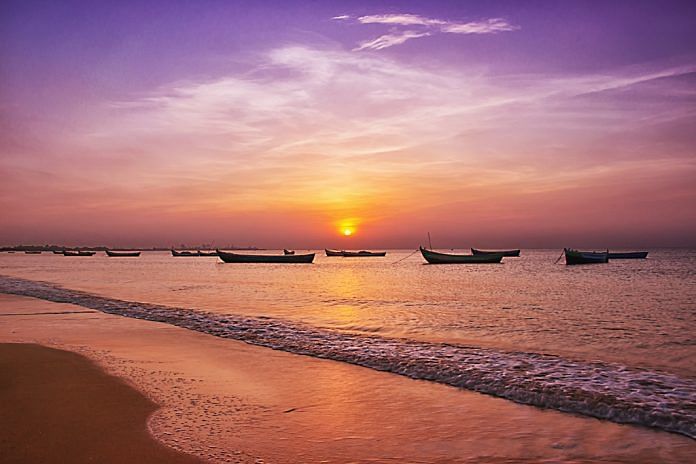For the curious Indian reader who emerged fairly clueless from school history classes, Coromandel is a good place to start exploring the rich, storied diversity of the region.
Coromandel: A Personal History of South India by India-born British historian Charles Allen sets out to shine a light on the story of the subcontinental that lies south of the Vindhyas. About time too, I’d say, given our traditional obsession with the history of the north and the British era. Here though is no dry recounting of information gleaned from the usual historical sources. Allen, who has travelled extensively across India through his adult life, skillfully weaves a lucid, eminently readable narrative, a rich tapestry of southern India’s geography, religious practices, trade and agricultural structures, social orders, and craft traditions, shot through with the magic of mythology, good old storytelling and an abiding affection for the land of his birth.
Beginning with the history of mankind – specifically, the out of Africa theory – Allen traces the arrival of early migrants into the southern peninsula and the evolution of the Dravidians, a people whose language distinguishes them comprehensively from the communities who later migrated here from northern India. Hindu mythology though links the north with the south in the form of Agastya – one of the seven great Vedic-era sages or saptarishis– who is traditionally believed to have arrived here from the north and gifted the land with two of its great defining features – the Tamil language and the fertile waters of the River Cauvery.
Be that as it may, the early centuries of the Common Era saw the evolution and growth of multiple non-Vedic faiths here, predominantly Jainism and Buddhism. These are the “lost chapters in India’s history”, says Allen, going on to add that their recovery began towards the late 18th century when the East India Company began to appoint surveyors of its expanding territory, “to establish what revenue returns the Company could expect.” Helped by several astute Indians, the surveyors recorded everything they observed about the life and times of the local communities. Today, evidence of the predominance of Jainism and Buddhism lives on in the form of numerous stupas and rock cut caves scattered across the southern states – a little nugget to carry with you on your next vacation down south.
The chapter Juggernaut captures how the traditions of an ancient, declining faith are co-opted by an emerging religion. Here, Allen posits that the famous rath-yatra of the JagannathPuri temple may, in all likelihood, have been adapted from the much older Buddhist practice of ceremonially parading the Buddha’s tooth relic in a chariot around the Buddhist temple where it was housed. There’s also an ancient tribal myth from which originated the deity who is now worshipped as Jagannath.
But on to Coromandel, a corruption of Cholamandalam, the great kingdom of the Tamil Cholarulers based in Tanjore. As is his wont, Allen diverges from the main story into an adventures of a young 16th century Italian sailor, Ludovico di Varthema, who may have coined the name Coromandel. By the time Ludovico arrived in India, the spice-growingMalabar region on the west coast was a thriving centre of trade with the Portuguese navy successfully displacing the existing monopoly of Arab traders. There’s a bloodcurdling tale of Vasco da Gama who bombarded the city of Calicut, armtwisting the Zamorin or local ruler to expel the Moors living there. Capturing hundreds of Muslim sailors, da Gama cut off their hands, noses, and ears and sent a boatload of the chopped organs to the ruler, ordering him to make a karil out of them – the first time, claims Allen, that this Tamil-derived word for kari(“sauce”) was observed in Western parlance, and which subsequently, as you’ve probably guessed,went on to become “curry”. Back to Ludovico, who accomplished what the mighty Portuguese armada could not – slipping through the natural stone Bridge of Rama at the tip of the subcontinent on a ciampana(“sampan”?)to land on India’s east coast at Nagapattinam, the centre of the Chola empire for over 1500 years.
Guiding us through this kingdom known for its magnificent, larger-than-life kings and queens and their prolific temple building, Allen devotes a special space to the Cholas’ patronage of local artisans famed worldwide now for their bronze statues of Hindu divinities.
Malaya Into Malabar is a multilayered account of the history of today’s Kerala, from its mythic creation by the Sage Parashurama to the portrayal of the Nairs, famed both for their fighting skills and matrilineal social structure. Equally engrossing is the reformist journey of this green strip of land, from caste oppression and rigid religious mores to the modern state that now regularly tops national literacy and health parameters.
Coromandel sweeps through southern India’s history, religions, archaeology, legends, and socioeconomic structures, peppered with anecdotes and fine photographs, all of it cohering in the end to leave a deeper understanding of the linkages between the region’s past and its contemporary political and social landscape. Allen’s narrative does lag in places where he painstakingly details the sources of his narrative. For the curious Indian reader who emerged fairly clueless from school history classes about the land south of the Vindhyas, Coromandel is a good place to start exploring the rich, storied diversity of the region.
Poornima Narayanan is a Delhi-based freelance writer and editor.
 ‘Coromandel: A Personal History of South India by Charles Allen’ has been published by Little, Brown.
‘Coromandel: A Personal History of South India by Charles Allen’ has been published by Little, Brown.






